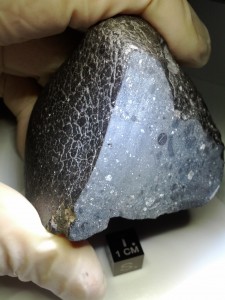
A meteorite contrail is seen over a village in Russia’s Chelyabinsk region on Friday, Feb. 15, 2013. (AP)
Earth suddenly seems to be dodging celestial objects, although there was a direct hit earlier today when a streaking meteorite exploded above Russia’s Ural Mountains.
Hundreds of people were injured. The powerful blast damaged the facades of buildings and shattered windows, according to the Russian Interior Ministry,
Now all eyes are on an asteroid that should zip past our planet today at 1924 UTC. However, experts say we are in no danger from asteroid 2012 DA14.
“According to NASA scientists, the trajectory of the Russian meteorite was significantly different than the trajectory of the asteroid 2012 DA14, making it a completely unrelated object. Information is still being collected about the Russian meteorite and analysis is preliminary at this point. In videos of the meteor, it is seen to pass from left to right in front of the rising sun, which means it was traveling from north to south. Asteroid DA14′s trajectory is in the opposite direction, from south to north.”

This animated set of images depicts asteroid 2012 DA14 as it was seen on 02-14-13, at a distance of 748,000 kilometers. The asteroid is the large bright spot moving near the middle of image. The other dots are stars in the background. A line that appears comes from a satellite that passed through the field of view.(Image credit: LCOGT/E. Gomez/Faulkes South/Remanzacco Observatory)
The asteroid is expected to fly past us at a speed of about 7.8 kilometers per second, coming within 27,000 kilometers of Earth. That’s close enough so that it will pass inside the ring of geosynchronous weather and communications satellites that circle our planet at about 36,000 kilometers above Earth.

The Barringer (or Meteor) Crater in Arizona measures 180 meters deep and 1,200 meters wide. Scientists estimate that a small asteroid, about the same size as the passing 2012 DA14, created the hole some 25,000 years ago. (Photo: Kevin Walsh @ Creative Commons via Flickr)
NASA, which has been studying the asteroid’s path, says there’s no chance the asteroid might collide with Earth. The flyby will, however, provide a unique opportunity for researchers to study a near-Earth object up close.
The 2012 DA14 asteroid is about 45 meters across, less than the width of a soccer field, weighs about 130,000 metric tons, and is most likely made of stone, rather than metal or ice.
Although the passing asteroid is relatively small in size, it could pack a mighty punch if it did swerve out of its projected path and hit the Earth.
Jack Rozdilsky an emergency management expert at Western Illinois University has considered the possibility of a hit.
 “If the 150-foot asteroid passing Earth on Friday were on a collision course with the planet, it would impact the surface with an explosive force of 2.4 megatons of TNT,” Rozdilsky said.
“If the 150-foot asteroid passing Earth on Friday were on a collision course with the planet, it would impact the surface with an explosive force of 2.4 megatons of TNT,” Rozdilsky said.
While such a hit would not be planet destroying, it could wipe out a large metropolitan area in a one single blow.
“While popular disaster films such as ‘Armageddon’ have depicted fictionalized accounts of asteroids threatening Earth, asteroid impacts on Earth are not necessarily far-fetched,” Rozdilsky said. “In 1908, a comet impacted Tunguska, a forest in a remote area of northern Russia, with the resultant explosion devastating a large unpopulated area.”
A NASA animation show the trajectory of asteroid 2012 DA14 as it travels within the Earth-moon system on Feb. 15, 2013





 Science World is VOA’s on-air and online magazine covering science, health, technology and the environment.
Science World is VOA’s on-air and online magazine covering science, health, technology and the environment.